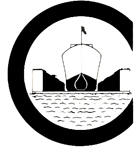Over 150 years of expertise in marine railways and floating dry docks
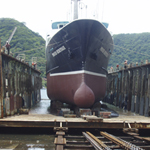 |
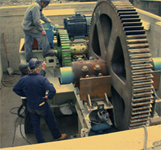 |
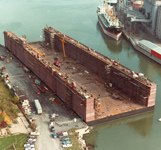 |
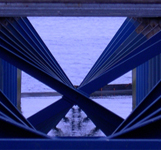 |
|
An
Introduction to Railway Dry Docks
and Transfer Systems
Part
12 - Vertical Lifting vs. Inclined Ways
|
3. Side haul railway dry docks |
Vertical lifting can be considered as a limiting, special case of the railway dry dock, in the sense that the slope is infinite. The cradle becomes a platform, the track disappears, and the hauling machine, rather than hauling only a component of the weight, must lift the entire ship and platform. Since no inclined ways exist to provide support, the uplift, rather than begin applied at the 1/3 points on the beams, is applied at the side extremities of the platform. Because of this difference in where the lift is exerted, extra strength is required for the platform beans (compared to the cradle beams) to keep the transverse bending within acceptable limits. The extra strength is achieved at the cost of much higher dead weight. A common method of providing uplift is by a number of wirerope winches on each side of the platform. The same problems of overloading can occur as with a marine railway; any severe load concentrations on the platform must be supported by the cables going to the hoists in the way of these loads. Failure of cables, hoists, or platform beams results in catastrophic damage to the vessel; and weakening of wire ropes cannot be detected as can wear or stretch of hauling chains. The railway dry dock has the basic advantage over vertical lifting devices that the cradle lis supported form below, so that the transverse bending of the steel frame amounts to only 25% of that of a lift's platform. Furthermore, if a hauling chain should break, the cradle is free to roll down its ways with no damage to the dock or vessel. With respect to space occupancy, the lift proper requires less than the marine railway, but the advantage is gained at the cost of building expensive walls or constructing the lift offshore with a longitudinal trestle going inshore. With the trestle solution, about as much space is required as for a steep-slope railway, and protection of long piles is a problem. Either the trestle or the walls result in a total installation cost greater than that of the railway. Actually the inclined track of a railway dry dock is generally not a liability because it usually follows the natural slope of the existing bottom and so it is not a navigational hazard. In summary, the reasons for choosing a railway dry dock over a lift are as follows:
|
Progress...the result of never being satisfied
Crandall
Dry Dock Engineers, Inc.
Established 1854
(888) DRYDOCK crandalldd@aol.com
